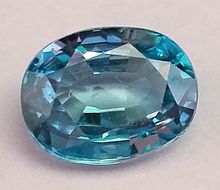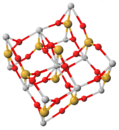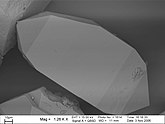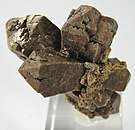Zircon
| Zircon | |
|---|---|
 A lustrous crystal of zircon perched on a tan matrix of calcite from the Gilgit District of Pakistan | |
| General | |
| Category | Nesosilicates |
| Formula (repeating unit) | zirconium silicate (ZrSiO4) |
| IMA symbol | Zrn[1] |
| Strunz classification | 9.AD.30 |
| Crystal system | Tetragonal |
| Crystal class | Ditetragonal dipyramidal (4/mmm) H-M symbol: (4/m 2/m 2/m) |
| Space group | I41/amd (No. 141) |
| Unit cell | a = 6.607(1), c = 5.982(1) [Å]; Z = 4 |
| Identification | |
| Color | Reddish brown, yellow, green, blue, gray, colorless; in thin section, colorless to pale brown |
| Crystal habit | tabular to prismatic crystals, irregular grains, massive |
| Twinning | On {101}. Crystals shocked by meteorite impact show polysynthetic twins on {112} |
| Cleavage | {110} and {111} |
| Fracture | Conchoidal to uneven |
| Tenacity | Brittle |
| Mohs scale hardness | 7.5 |
| Luster | Vitreous to adamantine; greasy when metamict. |
| Streak | White |
| Diaphaneity | Transparent to opaque |
| Specific gravity | 4.6–4.7 |
| Optical properties | Uniaxial (+) |
| Refractive index | nω = 1.925–1.961 nε = 1.980–2.015, 1.75 when metamict |
| Birefringence | δ = 0.047–0.055 |
| Pleochroism | Weak |
| Fusibility | close to 2,550 °C depend on Hf,Th,U,H,etc... concentrations. |
| Solubility | Insoluble |
| Other characteristics | Fluorescent and May form pleochroic halos, Relief: high |
| References | [2][3][4][5][6] |
Zircon (/ˈzɜːrkɒn, -kən/)[7][8][9] is a mineral belonging to the group of nesosilicates and is a source of the metal zirconium. Its chemical name is zirconium(IV) silicate, and its corresponding chemical formula is ZrSiO4. An empirical formula showing some of the range of substitution in zircon is (Zr1–y, REEy)(SiO4)1–x(OH)4x–y. Zircon precipitates from silicate melts and has relatively high concentrations of high field strength incompatible elements. For example, hafnium is almost always present in quantities ranging from 1 to 4%. The crystal structure of zircon is tetragonal crystal system. The natural color of zircon varies between colorless, yellow-golden, red, brown, blue, and green.
The name derives from the Persian zargun, meaning "gold-hued".[10] This word is changed into "jargoon", a term applied to light-colored zircons. The English word "zircon" is derived from Zirkon, which is the German adaptation of this word.[11] Yellow, orange, and red zircon is also known as "hyacinth",[12] from the flower hyacinthus, whose name is of Ancient Greek origin.
Properties
[edit]
Zircon is common in the crust of Earth. It occurs as a common accessory mineral in igneous rocks (as primary crystallization products), in metamorphic rocks and as detrital grains in sedimentary rocks.[2] Large zircon crystals are rare. Their average size in granite rocks is about 0.1–0.3 mm (0.0039–0.0118 in), but they can also grow to sizes of several cm, especially in mafic pegmatites and carbonatites.[2] Zircon is fairly hard (with a Mohs hardness of 7.5) and chemically stable, and so is highly resistant to weathering. It also is resistant to heat, so that detrital zircon grains are sometimes preserved in igneous rocks formed from melted sediments.[13] Its resistance to weathering, together with its relatively high specific gravity (4.68), make it an important component of the heavy mineral fraction of sandstones.[5]
Because of their uranium[14] and thorium content, some zircons undergo metamictization. Connected to internal radiation damage, these processes partially disrupt the crystal structure and partly explain the highly variable properties of zircon. As zircon becomes more and more modified by internal radiation damage, the density decreases, the crystal structure is compromised, and the color changes.[15]
Zircon occurs in many colors, including reddish brown, yellow, green, blue, gray, and colorless.[2] The color of zircons can sometimes be changed by heat treatment. Common brown zircons can be transformed into colorless and blue zircons by heating to 800 to 1,000 °C (1,470 to 1,830 °F).[16] In geological settings, the development of pink, red, and purple zircon occurs after hundreds of millions of years, if the crystal has sufficient trace elements to produce color centers. Color in this red or pink series is annealed in geological conditions above temperatures of around 400 °C (752 °F).[17]
Structurally, zircon consists of parallel chains of alternating silica tetrahedra (silicon ions in fourfold coordination with oxygen ions) and zirconium ions, with the large zirconium ions in eightfold coordination with oxygen ions.[18]
Applications
[edit]
Zircon is mainly consumed as an opacifier, and has been known to be used in the decorative ceramics industry.[19] It is also the principal precursor not only to metallic zirconium, although this application is small, but also to all compounds of zirconium including zirconium dioxide (ZrO2), an important refractory oxide with a melting point of 2,717 °C (4,923 °F).[20]
Other applications include use in refractories and foundry casting and a growing array of specialty applications as zirconia and zirconium chemicals, including in nuclear fuel rods, catalytic fuel converters and in water and air purification systems.[21]
Zircon is one of the key minerals used by geologists for geochronology.[22]
Zircon is a part of the ZTR index to classify highly-weathered sediments.[23]
Gemstone
[edit]

Transparent zircon is a well-known form of semi-precious gemstone, favored for its high specific gravity (between 4.2 and 4.86) and adamantine luster. Because of its high refractive index (1.92) it has sometimes been used as a substitute for diamond, though it does not display quite the same play of color as a diamond. Zircon is one of the heaviest types of gemstone.[24] Its Mohs hardness is between that of quartz and topaz, at 7.5 on the 10 point scale, though below that of the similar manmade stone cubic zirconia (8-8.5). Zircons may sometimes lose their inherent color after long exposure to bright sunlight, which is unusual in a gemstone. It is immune to acid attack except by sulfuric acid and then only when ground into a fine powder.[25]
Most gem-grade zircons show a high degree of birefringence which, on stones cut with a table and pavilion cuts (i.e., nearly all cut stones), can be seen as the apparent doubling-up of the latter when viewed through the former, and this characteristic can be used to distinguish them from diamonds and cubic zirconias (CZ) as well as soda-lime glass, none of which show this characteristic. However, some zircons from Sri Lanka display only weak or no birefringence at all, and some other Sri Lanka stones may show clear birefringence in one place and little or none in another part of the same cut stone.[26] Other gemstones also display birefringence, so while the presence of this characteristic may help distinguish a given zircon from a diamond or a CZ, it will not help distinguish it from, for example, a topaz gemstone. The high specific gravity of zircon, however, can usually separate it from any other gem and is simple to test.
Also, birefringence depends on the cut of the stone in relation to its optical axis. If a zircon is cut with this axis perpendicular to its table, birefringence may be reduced to undetectable levels unless viewed with a jeweler's loupe or other magnifying optics. The highest grade zircons are cut to minimize birefringence.[27]
The value of a zircon gem depends largely on its color, clarity, and size. Prior to World War II, blue zircons (the most valuable color) were available from many gemstone suppliers in sizes between 15 and 25 carats; since then, stones even as large as 10 carats have become very scarce, especially in the most desirable color varieties.[27]
Synthetic zircons have been created in laboratories.[28] They are occasionally used in jewellery such as earrings. Zircons are sometimes imitated by spinel and synthetic sapphire, but are not difficult to distinguish from them with simple tools.
Zircon from Ratanakiri province in Cambodia is heat treated to produce blue zircon gemstones, sometimes referred to by the trade name cambolite.[29]
Occurrence
[edit]
Zircon is a common accessory to trace mineral constituent of all kinds of igneous rocks, but particularly granite and felsic igneous rocks. Due to its hardness, durability and chemical inertness, zircon persists in sedimentary deposits and is a common constituent of most sands.[30][31] Zircon can occasionally be found as a trace mineral in ultrapotassic igneous rocks such as kimberlites, carbonatites, and lamprophyre, owing to the unusual magma genesis of these rocks.[citation needed]
Zircon forms economic concentrations within heavy mineral sands ore deposits, within certain pegmatites, and within some rare alkaline volcanic rocks, for example the Toongi Trachyte, Dubbo, New South Wales Australia[32] in association with the zirconium-hafnium minerals eudialyte and armstrongite.
Australia leads the world in zircon mining, producing 37% of the world total and accounting for 40% of world EDR (economic demonstrated resources) for the mineral.[33] South Africa is Africa's main producer, with 30% of world production, second after Australia.[34]
Radiometric dating
[edit]
Zircon has played an important role during the evolution of radiometric dating. Zircons contain trace amounts of uranium and thorium (from 10 ppm up to 1 wt%)[14] and can be dated using several modern analytical techniques. Because zircons can survive geologic processes like erosion, transport, even high-grade metamorphism, they contain a rich and varied record of geological processes. Currently, zircons are typically dated by uranium-lead (U-Pb), fission-track, and U+Th/He techniques. Imaging the cathodoluminescence emission from fast electrons can be used as a prescreening tool for high-resolution secondary-ion-mass spectrometry (SIMS) to image the zonation pattern and identify regions of interest for isotope analysis. This is done using an integrated cathodoluminescence and scanning electron microscope.[35] Zircons in sedimentary rock can identify the sediment source.[36]
Zircons from Jack Hills in the Narryer Gneiss Terrane, Yilgarn Craton, Western Australia, have yielded U-Pb ages up to 4.404 billion years,[37] interpreted to be the age of crystallization, making them the oldest minerals so far dated on Earth. In addition, the oxygen isotopic compositions of some of these zircons have been interpreted to indicate that more than 4.3 billion years ago there was already liquid water on the surface of the Earth.[37][38][39][40] This interpretation is supported by additional trace element data,[41][42] but is also the subject of debate.[43][44][45] In 2015, "remains of biotic life" were found in 4.1-billion-year-old rocks in the Jack Hills of Western Australia.[46][47] According to one of the researchers, "If life arose relatively quickly on Earth ... then it could be common in the universe."[46]
Similar minerals
[edit]Hafnon (HfSiO4), xenotime (YPO4), béhierite, schiavinatoite ((Ta,Nb)BO4), thorite (ThSiO4), and coffinite (USiO4)[14] all share the same crystal structure (IVX IVY O4, IIIX VY O4 in the case of xenotime) as zircon.
Gallery
[edit]- Crystal structure of zircon
- Unit cell of zircon
- Scanning electron microscope image of zircon
- Unusual olive-green zircon
- Cluster of three compound crystals of zircon
See also
[edit]References
[edit]- ^ Warr, L.N. (2021). "IMA–CNMNC approved mineral symbols". Mineralogical Magazine. 85 (3): 291–320. Bibcode:2021MinM...85..291W. doi:10.1180/mgm.2021.43. S2CID 235729616.
- ^ a b c d Anthony, John W.; Bideaux, Richard A.; Bladh, Kenneth W.; Nichols, Monte C., eds. (1995). "Zircon" (PDF). Handbook of Mineralogy. Vol. II (Silica, Silicates). Chantilly, VA, US: Mineralogical Society of America. ISBN 978-0962209710.
- ^ "Zircon: Mineral information, data and localities". Mindat.org. Retrieved October 19, 2021.
- ^ "Zircon Mineral Data". Webmineral. Retrieved October 19, 2021.
- ^ a b Hurlbut, Cornelius S.; Klein, Cornelis (1985). Manual of Mineralogy (20th ed.). ISBN 0-471-80580-7.
- ^ Erickson, Timmons M.; Cavosie, Aaron J.; Moser, Desmond E.; et al. (2013). "Correlating planar microstructures in shocked zircon from the Vredefort Dome at multiple scales: Crystallographic modeling, external and internal imaging, and EBSD structural analysis" (PDF). American Mineralogist. 98 (1). Abstract: 53–65. Bibcode:2013AmMin..98...53E. doi:10.2138/am.2013.4165. S2CID 67779734.
- ^ "zircon". CollinsDictionary.com. HarperCollins. Retrieved April 29, 2018.
- ^ "zircon". The American Heritage Dictionary of the English Language (5th ed.). HarperCollins.
- ^ "zircon". Merriam-Webster.com Dictionary. Merriam-Webster. Retrieved April 29, 2018.
- ^ Stwertka, Albert (1996). A Guide to the Elements. Oxford University Press. pp. 117–119. ISBN 978-0-19-508083-4.
- ^ Harper, Douglas. "zircon". Online Etymology Dictionary.
- ^ "Hyacinth (gem)". Encyclopædia Britannica. Encyclopædia Britannica Inc. Retrieved October 7, 2016.
- ^ Nesse, William D. (2000). Introduction to mineralogy. New York: Oxford University Press. pp. 313–314. ISBN 9780195106916.
- ^ a b c Jackson, Robert A.; Montenari, Michael (2019). "Computer modeling of Zircon (ZrSiO4)—Coffinite (USiO4) solid solutions and lead incorporation: Geological implications". Stratigraphy & Timescales. 4: 217–227. doi:10.1016/bs.sats.2019.08.005. ISBN 9780128175521. S2CID 210256739 – via Elsevier Science Direct.
- ^ Nesse 2000, pp. 93–94.
- ^ "Zircon gemstone information". www.gemdat.org. Retrieved April 29, 2018.
- ^ Garver, John I.; Kamp, Peter J.J. (2002). "Integration of zircon color and zircon fission-track zonation patterns in orogenic belts: Application to the Southern Alps, New Zealand". Tectonophysics. 349 (1–4): 203–219. Bibcode:2002Tectp.349..203G. CiteSeerX 10.1.1.570.3912. doi:10.1016/S0040-1951(02)00054-9.
- ^ Nesse 2000, p. 313.
- ^ Nielsen, Ralph (2000). "Zirconium and Zirconium Compounds". Ullmann's Encyclopedia of Industrial Chemistry. doi:10.1002/14356007.a28_543. ISBN 978-3527306732.
- ^ Davis, Sergio; Belonoshko, Anatoly; Rosengren, Anders; Duin, Adri; Johansson, Börje (January 1, 2010). "Molecular dynamics simulation of zirconia melting". Open Physics. 8 (5): 789. Bibcode:2010CEJPh...8..789D. doi:10.2478/s11534-009-0152-3. S2CID 120967147.
- ^ "Products". Mineral Commodities Ltd. Archived from the original on October 7, 2016. Retrieved August 8, 2016.
- ^ Nesse 2000, p. 314.
- ^ Blatt, Harvey; Middleton, Gerard; Murray, Raymond (1980). Origin of sedimentary rocks (2d ed.). Englewood Cliffs, N.J.: Prentice-Hall. pp. 321–322. ISBN 0136427103.
- ^ Brauns, Reinhard (1912). The Mineral Kingdom (Volume 1). Translated by Leonard James Spencer. J.F. Schreiber. p. 217.
- ^ Oliver Cummings Farrington (1903). Gems and Gem Minerals. A.W. Mumford. p. 109.
- ^ L.J. Spencer (1905). Report of the Seventy-Fourth Meeting of the British Association for the Advancement of Science. John Murray. pp. 562–563.
- ^ a b "Physical & Optical Properties of Zircon". Colored Gemstones Guide. Retrieved October 19, 2021.
- ^ Van Westrenen, Wim; Frank, Mark R.; Hanchar, John M.; Fei, Yingwei; Finch, Robert J.; Zha, Chang-Sheng (January 2004). "In situ determination of the compressibility of synthetic pure zircon (ZrSiO4) and the onset of the zircon-reidite phase transition". American Mineralogist. 89 (1): 197–203. Bibcode:2004AmMin..89..197V. doi:10.2138/am-2004-0123. S2CID 102001496.
- ^ ""Blue Zircon Cambolite"".
- ^ Nesse 2000, pp. 313–314.
- ^ Hurlbut & Klein 1985, p. 454.
- ^ Staff (June 2007). "Dubbo Zirconia Project Fact Sheet June 2014" (PDF). Alkane Resources Limited. Archived from the original (PDF) on February 28, 2008. Retrieved September 10, 2007.
- ^ "The Mineral Sands Industry Factbook" (PDF). Archived from the original (PDF) on August 18, 2016.
- ^ "Heavy Minerals Mining in Africa – Titanium And Zirconium". Archived from the original on May 28, 2008. Retrieved August 8, 2016.
- ^ "Zircons – Application Note". DELMIC. Retrieved February 10, 2017.
- ^ Cawood, P.A.; Hawkesworth, C.J.; Dhuime, B. (October 2012). "Detrital zircon record and tectonic setting". Geology. 40 (10): 875–878. Bibcode:2012Geo....40..875C. doi:10.1130/G32945.1. hdl:10023/3575.
- ^ a b Wilde, Simon A.; Valley, John W.; Peck, William H.; Graham, Colin M. (2001). "Evidence from detrital zircons for the existence of continental crust and oceans on the Earth 4.4 Gyr ago". Nature. 409 (6817): 175–178. Bibcode:2001Natur.409..175W. doi:10.1038/35051550. PMID 11196637. S2CID 4319774.
- ^ Mojzsis, Stephen J.; Harrison, T. Mark; Pidgeon, Robert T. (2001). "Oxygen-isotope evidence from ancient zircons for liquid water at the Earth's surface 4,300 Myr ago". Nature. 409 (6817): 178–181. doi:10.1038/35051557. PMID 11196638. S2CID 2819082.
- ^ Valley, JW; Peck, WH; King, EM; Wilde, SA (2002). "A cool early Earth". Geology. 30 (4): 351–354. Bibcode:2002Geo....30..351V. doi:10.1130/0091-7613(2002)030<0351:ACEE>2.0.CO;2.
- ^ Valley, JW; Lackey, JS; Cavosie, AJ (2005). "4.4 billion years of crustal maturation: Oxygen isotopes in magmatic zircon". Contributions to Mineralogy and Petrology. 150: 561–580. doi:10.1007/s00410-005-0025-8. S2CID 53118854.
- ^ Ushikubo, Takayuki; Kita, Noriko T.; Cavosie, Aaron J.; Wilde, Simon A.; Rudnick, Roberta L.; Valley, John W. (2008). "Lithium in Jack Hills zircons: Evidence for extensive weathering of Earth's earliest crust". Earth and Planetary Science Letters. 272 (3–4): 666–676. Bibcode:2008E&PSL.272..666U. doi:10.1016/j.epsl.2008.05.032.
- ^ "Ancient mineral shows early Earth climate tough on continents". Physorg.com. June 13, 2008.
- ^ Nemchin, A.; Pidgeon, R.; Whitehouse, M. (2006). "Re-evaluation of the origin and evolution of >4.2 Ga zircons from the Jack Hills metasedimentary rocks". Earth and Planetary Science Letters. 244 (1–2): 218–233. Bibcode:2006E&PSL.244..218N. doi:10.1016/j.epsl.2006.01.054.
- ^ Cavosie, A.J.; Valley, J.W.; Wilde, S.A. (2005). "Magmatic δ18O in 4400–3900 Ma detrital zircons: A record of the alteration and recycling of crust in the Early Archean". Earth and Planetary Science Letters. 235 (3–4): 663–681. Bibcode:2005E&PSL.235..663C. doi:10.1016/j.epsl.2005.04.028.
- ^ Valley, JW; Cavosie, AJ; Ushikobo, T; Reinhardt; Lawrence, DF; Larson, DJ; Clifton, PH; Kelly, TF; Wilde, SA; Moser, DE; Spicuzza, MJ (2014). "Hadean age for a post-magma-ocean zircon confirmed by atom-probe tomography". Nature Geoscience. 7 (3): 219–223. doi:10.1038/ngeo2075.
- ^ a b Borenstein, Seth (October 19, 2015). "Hints of life on what was thought to be desolate early Earth". Excite. Yonkers, NY: Mindspark Interactive Network. Associated Press. Archived from the original on October 23, 2015. Retrieved October 8, 2018.
- ^ Bell, Elizabeth A.; Boehnke, Patrick; Harrison, T. Mark; Mao, Wendy L. (2015). "Potentially biogenic carbon preserved in a 4.1 billion-year-old zircon". Proceedings of the National Academy of Sciences. 112 (47): 14518–14521. Bibcode:2015PNAS..11214518B. doi:10.1073/pnas.1517557112. PMC 4664351. PMID 26483481.
Further reading
[edit]- John M. Hanchar & Paul W. O. Hoskin, eds. (2003). "Zircon". Reviews in Mineralogy and Geochemistry (Mineralogical Society of America monograph). 53. ISBN 0-939950-65-0.
- D. J. Cherniak & E. B. Watson (2000). "Pb diffusion in zircon". Chemical Geology. 172 (1–2): 5–24. Bibcode:2001ChGeo.172....5C. doi:10.1016/S0009-2541(00)00233-3.
- A. N. Halliday (2001). "In the beginning…". Nature. 409 (6817): 144–145. doi:10.1038/35051685. PMID 11196624. S2CID 4339433.
- Hermann Köhler (1970). "Die Änderung der Zirkonmorphologie mit dem Differentiationsgrad eines Granits". Neues Jahrbuch für Mineralogie - Monatshefte. 9: 405–420.
- K. Mezger & E. J. Krogstad (1997). "Interpretation of discordant U-Pb zircon ages: An evaluation". Journal of Metamorphic Geology. 15 (1): 127–140. Bibcode:1997JMetG..15..127M. doi:10.1111/j.1525-1314.1997.00008.x. S2CID 129846813.
- J. P. Pupin (1980). "Zircon and Granite petrology". Contributions to Mineralogy and Petrology. 73 (3): 207–220. Bibcode:1980CoMP...73..207P. doi:10.1007/BF00381441. S2CID 96470918.
- Gunnar Ries (2001). "Zirkon als akzessorisches Mineral". Aufschluss. 52: 381–383.
- G. Vavra (1990). "On the kinematics of zircon growth and its petrogenetic significance: a cathodoluminescence study". Contributions to Mineralogy and Petrology. 106 (1): 90–99. Bibcode:1990CoMP..106...90V. doi:10.1007/BF00306410. S2CID 140566387.
- John W. Valley; William H. Peck; Elizabeth M. King; Simon A. Wilde (2002). "A Cool Early Earth". Geology. 30 (4): 351–354. Bibcode:2002Geo....30..351V. doi:10.1130/0091-7613(2002)030<0351:ACEE>2.0.CO;2. Archived from the original on March 4, 2005. Retrieved April 11, 2005.
- G. Vavra (1994). "Systematics of internal zircon morphology in major Variscan granitoid types". Contributions to Mineralogy and Petrology. 117 (4): 331–344. Bibcode:1994CoMP..117..331V. doi:10.1007/BF00307269. S2CID 128459636.
External links
[edit]- Geochemistry of old zircons. Archived April 12, 2007, at the Wayback Machine.
- Mineral galleries (archived 7 April 2005)
- GIA Gem Encyclopedia – Zircon Online articles and information on zircon history, lore, and research
- Zircon Industry Association


 French
French Deutsch
Deutsch



